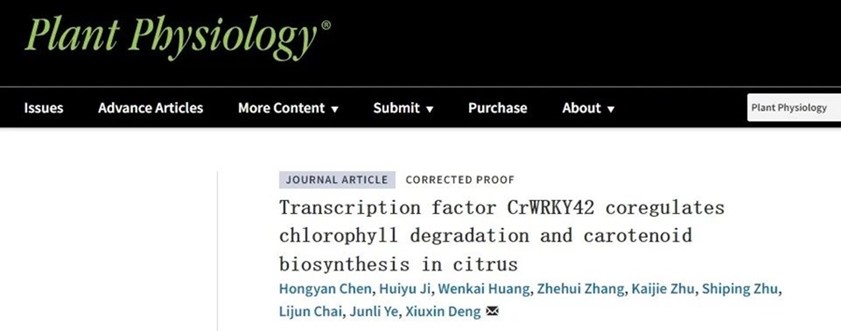
Recently, the team of Academician Deng Xiuxin from the National Key Laboratory of Germplasm Innovation & Utilization of Horticultural Crops in the College of Horticulture & Forestry Sciences at HZAU, published a research paper titled “Transcription factor CrWRKY42 coregulates chlorophyll degradation and carotenoid biosynthesis in citrus” online in Plant Physiology. The study elucidated the molecular mechanism by which the transcription factor CrWRKY42 promotes fruit coloring in citrus by co-regulating chlorophyll degradation and carotenoid biosynthesis pathways, providing a theoretical basis and important gene resources for genetic improvement of citrus fruit color and quality.
Citrus, one of the world’s most important fruit trees, holds immense industrial and economic value. In recent years, China’s citrus industry has experienced rapid growth, with both planting area and production volume ranking first globally, accounting for approximately one-third of the world’s output. Fruit coloration stands as a significant quality attribute of citrus fruits, with chlorophyll and carotenoid composition and contents determining their appearance. Chlorophyll degradation and carotenoid biosynthesis, two metabolic pathways, are extremely complex and regulated by multiple genes, nodes, and factors. During citrus fruit ripening, chlorophyll degradation and carotenoid biosynthesis occur almost simultaneously. However, the synergistic regulation of these two processes at the transcriptional level remains largely unknown.

This study identified a WRKY family transcription factor, CrWRKY42, involved in the coloration process of citrus fruits, transcriptome data of “Shiranuhi’ tangor” and its yellowish bud mutant “Jinlegan”. In citrus callus, overexpression of CrWRKY42 led to significant upregulation of multiple carotenoid biosynthetic genes such as phytoene desaturase(CrPDS), lycopene β-cyclase2(CrLCYB2), and β-carotene hydroxylase1(CrBCH1), promoting carotenoid accumulation. Conversely, interference of CrWRKY42 in citrus calli significantly reduced the total carotenoid content and suppressed the expression levels of several carotenoid biosynthesis-related genes. In addition, transient overexpression and interference of the CrWRKY42 in citrus fruits revealed its ability to simultaneously activate the expression of key genes involved in both chlorophyll degradation and carotenoid biosynthesis, coordinating the regulation of two metabolic pathways, thereby promoting the conversion of citrus fruit color. The experiments have shown that CrWRKY42 could directly bind to the W-box elements on the promoter of CrBCH1 and activate its expression. And the further assays confirmed that CrWRKY42 could also directly bind and activate the promoters of multiple chlorophyll degradation and carotenoid biosynthesis genes, including NONYELLOW COLORING (CrNYC), STAY-GREEN (CrSGR), CrPDS, and CrLCYB2.
The data reveals that CrWRKY42, as a direct positive regulator of chlorophyll degradation and carotenoid biosynthesis, plays a significant role in citrus fruit coloration. Their findings offer insight into the complex transcriptional regulation of chlorophyll and carotenoid metabolism during fruit ripening, providing guidance for improving and regulating fruit color and quality.
Academician Deng Xiuxin from the College of Horticulture & Forestry Sciences of HZAU is the corresponding author of this paper, with Ph.D student Chen Hongyan as the first author. The contributors also include Master’s student Ji Huiyu, Ph.D students Huang Wenkai and Zhang Zhehui, postdoctoral researcher Zhu Kaijie, Associate Researcher Ye Junli, and Professor Chai Lijun from HZAU, as well as Associate Researcher Zhu Shiping from the Citrus Research Institute of the Chinese Academy of Agricultural Sciences. The research was funded by the National Key Research and Development Program of China and the National Natural Science Foundation of China.
Source:https://news.hzau.edu.cn/2024/0227/69057.shtml
Translated by:He Qiuyan
Proofread by: Fu Shipeng
Supervised by:Jin Bei
